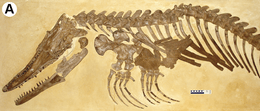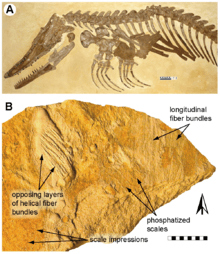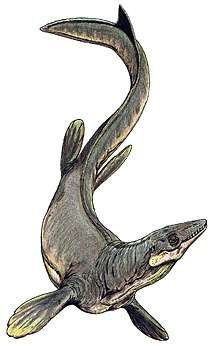Ectenosaurus
Ectenosaurus is an extinct genus of marine lizard belonging to the mosasaur family. It is classified as part of the Plioplatecarpinae subfamily alongside genera like Angolasaurus and Platecarpus. Ectenosaurus is known from the Santonian and Campanian of Kansas, Alabama, and Texas.
| Ectenosaurus | |
|---|---|
 | |
| Partial skeleton of Ectenosaurus clidastoides. | |
| Scientific classification | |
| Kingdom: | |
| Phylum: | |
| Class: | |
| Order: | |
| Superfamily: | |
| Family: | |
| Subfamily: | |
| Genus: | †Ectenosaurus Russell, 1967 |
| Binomial name | |
| †Ectenosaurus clidastoides Merriam, 1894 | |
| Synonyms | |
| |
The generic name means "Drawn-out lizard", from Greek ectenes ("drawn-out") and Greek sauros ("lizard") referencing the elongated muzzle.
Description

Based on the size of the preserved skull, about 74 centimeters in length, Ectenosaurus would have reached sizes of 5,7 meters in length. It was a rare genus of mosasaur with several unique characteristics that clearly separate it from other mosasaur genera. The most prominent of these features is its elongated jaws, elongated in a similar vein to other mosasaurs with elongated jaws, such as Plotosaurus and Pluridens.
Russell (1967) considered the form of the teeth, the shape of the frontal and the large suprastapedial process of the quadrate as evidence of a close relation between Ectenosaurus and Platecarpus. He separated Ectenosaurus from Platecarpus based on the elongated snout, the exclusion of the prefrontals from the narial borders and the fusion of the supra- and infrastepedial processes.[1]
Scales and locomotion
The specimen FHSM VP-401 preserve significantly comprehensive skin impressions from Ectenosaurus, which makes it possible to draw conclusions not only about mosasaur integument at large but also about mosasaur movement and propulsion. The scales are considerably smaller in size (2.7×2.0 mm) than those found in the famed LACM 128319 specimen of Platecarpus (3.8×4.4 mm), despite the animals being of similar sizes.[2]
The combination of small and firmly anchored body scales as well as a complex meshwork of alternating crossed-helical and longitudinal fiber bundles suggest that the anterior torso of Ectenosaurus was reasonably stiff. This also suggests that this section of the body was quite rigid during locomation, and that the main form of propulsion would have to have been done by the tail (likely possessing a tail fin like other mosasaur species), and that it could not move by undulating its entire body like snakes do, a previously popular view of mosasaur locomotion.[2]
History of discovery
Ectenosaurus was originally described as a species of Platecarpus, P. clidastoides, in 1894. The type specimen was collected by C.H. Sternberg or G. Bauer from Logan County in Kansas and was housed in the Bayerische Staatssammlung fur Palaontologie in Munich, where it was likely destroyed during the Second World War. A second specimen (which was also much better preserved) was discovered by George Sternberg in 1953, which he initially identified as a Clidastes velox. The specimen, GFS 109-53, was about 3 meters in length and largely articulated, though the tail and rear limbs were missing due to erosion.[3]
This specimen was then exhibited at the Sternberg Memorial Museum on the campus of Fort Hays State University from its discovery until 1999 when the museum was closed and moved. Since the museum moved, the specimen remains in storage.[3] It was examined in 1963 by Dale A. Russell who determined that it represented a Platecarpus clidastoides and not a Clidastes velox. In his Systematics and Morphology of American Mosasaurs (1967) he re-described the species as part of a new genus, Ectenosaurus.[1]
Classification
Ectenosaurus has been seen as a plioplatecarpine for most of the time since its discovery, partly due to long having been classified as a species of Platecarpus. Some analyses recover it as a mosasaurine however, sharing close relations with Prognathodon.[4] The cladogram below follows Simões et al. (2017),[5] collapsed to only display the Plioplatecarpinae, and shows Ectenosaurus in relation to other plioplatecarpines.
| Plioplatecarpinae |
| |||||||||||||||||||||||||||||||||||||||
References
- Russell, Dale. A. (6 November 1967). "Systematics and Morphology of American Mosasaurs" (PDF). Bulletin of the Peabody Museum of Natural History (Yale University).
- Lindgren, Johan; Everhart, Michael J.; Caldwell, Michael W. (2011-11-16). "Three-Dimensionally Preserved Integument Reveals Hydrodynamic Adaptations in the Extinct Marine Lizard Ectenosaurus (Reptilia, Mosasauridae)". PLOS ONE. 6 (11): e27343. doi:10.1371/journal.pone.0027343. ISSN 1932-6203. PMC 3217950. PMID 22110629.
- "Ectenosaurus". oceansofkansas.com. Retrieved 2017-09-27.
- Conrad, J.L.; Ast, J.C.; Montanari, S.; Norell, M.A. (2010). "A combined evidence phylogenetic analysis of Anguimorpha (Reptilia: Squamata)". Cladistics. 27 (3): 230–277. doi:10.1111/j.1096-0031.2010.00330.x. ISSN 0748-3007.
- Simões, Tiago R.; Vernygora, Oksana; Paparella, Ilaria; Jimenez-Huidobro, Paulina; Caldwell, Michael W. (2017-05-03). "Mosasauroid phylogeny under multiple phylogenetic methods provides new insights on the evolution of aquatic adaptations in the group". PLOS ONE. 12 (5): e0176773. doi:10.1371/journal.pone.0176773. ISSN 1932-6203. PMC 5415187. PMID 28467456.
